Tunable Fano Resonances in an Ultra-Small Gap
Abstract
1. Introduction
2. Experimental Structure and Model Parameters
3. Results and Discussion
3.1. Observation and Proof of Fano Resonance
3.2. Effect of Nanocube-Substrate Spacing on Fano Resonance
3.3. Effect of Nanocube Size on Fano Resonance
3.4. Effect of Nanocube Dielectric Environment on Fano Resonance
4. Conclusions
Author Contributions
Funding
Acknowledgments
Conflicts of Interest
References
- Fano, U. Effects of configuration interaction on intensities and phase shifts. Phys. Rev. 1961, 124, 1866–1878. [Google Scholar] [CrossRef]
- Chen, H.; Shao, L.; Ming, T.; Woo, K.C.; Man, Y.C.; Wang, J.; Lin, H. Observation of the Fano Resonance in Gold Nanorods Supported on High-Dielectric-Constant Substrates. ACS Nano 2011, 5, 6754–6763. [Google Scholar] [CrossRef]
- Zheng, P.; Tang, H.; Liu, B.; Kasani, S.; Huang, L.; Wu, N. Origin of strong and narrow localized surface plasmon resonance of copper nanocubes. Nano Res. 2018, 12, 63–68. [Google Scholar] [CrossRef]
- Xu, L.; Li, F.; Liu, Y.; Yao, F.; Liu, S. Surface Plasmon Nanolaser: Principle, Structure, Characteristics and Applications. Appl. Sci. 2019, 9, 861. [Google Scholar] [CrossRef]
- Fang, Y.; Tian, X. Resonant surface plasmons of a metal nanosphere treated as propagating surface plasmons. Chin. Phys. B 2018, 27, 067302. [Google Scholar] [CrossRef]
- Lassiter, J.B.; Sobhani, H.; Fan, J.A.; Kundu, J.; Capasso, F.; Nordlander, P.; Halas, N.J. Fano resonances in plasmonic nanoclusters: Geometrical and chemical tunability. Nano Lett. 2010, 10, 3184–3189. [Google Scholar] [CrossRef]
- Zheludev, N.I.; Prosvirnin, S.L.; Papasimakis, N.; Fedotov, V.A. Coherent meta-materials and the lasing spaser. Nat. Photonics 2008, 2, 351–354. [Google Scholar] [CrossRef]
- Dicken, M.J.; Aydin, K.; Pryce, I.M.; Sweatlock, L.A.; Boyd, E.M.; Walavalkar, S.; Ma, J.; Atwater, H.A. Frequency tunable near-infrared metamaterials based on VO2 phase transition. Opt.Express 2009, 17, 18330–18339. [Google Scholar] [CrossRef]
- Lukyanchuk, B.S.; Tribelsky, M.I.; Wang, Z.; Zhou, Y.; Hong, M.; Shi, L.; Chong, T. Extraordinary scattering diagram for nanoparticles near plasmon resonance frequencies. Appl. Phys. 2007, 89, 259–264. [Google Scholar] [CrossRef]
- Nikolaenko, A.E.; De Angelis, F.; Boden, S.A.; Papasimakis, N.; Ashburn, P.; Di Fabrizio, E.; Zheludev, N.I. Carbon Nanotubes in a Photonic Metamaterial. Phys. Rev. Lett. 2010, 104, 153902. [Google Scholar] [CrossRef]
- Hu, G.; Hong, X.; Wang, K.; Wu, J.; Xu, H.-X.; Zhao, W.; Liu, W.; Zhang, S.; Garcia-Vidal, F.; Wang, B.; et al. Coherent steering of nonlinear chiral valley photons with a synthetic Au–WS2 metasurface. Nat. Photonics 2019, 13, 467–472. [Google Scholar] [CrossRef]
- Bao, Y.; Hu, Z.; Li, Z.; Zhu, X.; Fang, Z. Magnetic Plasmonic Fano Resonance at Optical Frequency. Small 2015, 11, 2177–2181. [Google Scholar] [CrossRef]
- Papasimakis, N.; Zheludev, N.I. Metamaterial-induced transparency: Sharp fano resonances and slow light. Opt. Photonics News 2009, 20, 22–27. [Google Scholar] [CrossRef]
- Ye, J.; Wen, F.; Sobhani, H.; Lassiter, J.B.; Van Dorpe, P.; Nordlander, P.; Halas, N.J. Plasmonic Nanoclusters: Near Field Properties of the Fano Resonance Interrogated with SERS. Nano Lett. 2012, 12, 1660–1667. [Google Scholar] [CrossRef]
- Miroshnichenko, A.E.; Flach, S.; Kivshar, Y.S. Fano resonances in nanoscale structures. Rev. Mod. Phys. 2010, 82, 2257–2298. [Google Scholar] [CrossRef]
- Luk’yanchuk, B.; Zheludev, N.I.; Maier, S.A.; Halas, N.J.; Nordlander, P.; Giessen, H.; Chong, C.T. The Fano resonance in plasmonic nanostructures and metamaterials. Nat. Mater. 2010, 9, 707–715. [Google Scholar] [CrossRef]
- Panaro, S.; De Angelis, F.; Toma, A. Dark and bright mode hybridization: From electric to magnetic Fano resonances. Opt. Laser. Eng. 2016, 76, 64–69. [Google Scholar] [CrossRef]
- Wang, M.; Wu, Z.; Krasnok, A.; Zhang, T.; Liu, M.; Liu, H.; Scarabelli, L.; Fang, J.; Liz-Marzan, L.M.; Terrones, M.; et al. Dark-Exciton-Mediated Fano Resonance from a Single Gold Nanostructure on Monolayer WS2 at Room Temperature. Small 2019, 15, 1900982. [Google Scholar] [CrossRef]
- Li, J.; Liu, T.; Zheng, H.; Dong, J.; He, E.; Hao, W.; Han, Q.; Wang, C.; Wu, Y. Higher Order Fano Resonances and Electric Field Enhancements in Disk-Ring Plasmonic Nanostructures with Double Symmetry Breaking. Plasmonics 2014, 9, 1439–1445. [Google Scholar] [CrossRef]
- Khan, A.D.; Miano, G. Plasmonic Fano Resonances in Single Layer Gold Conical Nanoshells. Plasmonics 2013, 8, 1429–1437. [Google Scholar] [CrossRef]
- Hu, Y.; Noelck, S.J.; Drezek, R.A. Symmetry Breaking in Gold-Silica-Gold Multilayer Nanoshells. ACS Nano 2010, 4, 1521–1528. [Google Scholar] [CrossRef]
- Pena-Rodriguez, O.; Rivera, A.; Campoy-Quiles, M.; Pal, U. Tunable Fano resonance in symmetric multilayered gold nanoshells. Nanoscale 2013, 5, 209–216. [Google Scholar] [CrossRef] [PubMed]
- Rahmani, M.; Luk’yanchuk, B.; Hong, M. Fano resonance in novel plasmonic nanostructures. Laser Photonics Rev. 2013, 7, 329–349. [Google Scholar] [CrossRef]
- Francescato, Y.; Giannini, V.; Maier, S.A. Plasmonic Systems Unveiled by Fano Resonances.pdf. ACS Nano 2012, 6, 1830–1838. [Google Scholar] [CrossRef] [PubMed]
- Campione, S.; Guclu, C.; Ragan, R.; Capolino, F. Fano resonances in metasurfaces made of linear trimers of plasmonic nanoparticles. Opt. Lett. 2013, 38, 5216–5219. [Google Scholar] [CrossRef] [PubMed]
- Zhao, W.; Ju, D.; Jiang, Y. Sharp Fano Resonance within Bi-periodic Silver Particle Array and Its Application as Plasmonic Sensor with Ultra-high Figure of Merit. Plasmonics 2014, 10, 469–474. [Google Scholar] [CrossRef]
- Liu, Z.; Ye, J. Highly controllable double Fano resonances in plasmonic metasurfaces. Nanoscale 2016, 8, 17665–17674. [Google Scholar] [CrossRef]
- Singh, A.K.; Ray, S.K.; Chandel, S.; Pal, S.; Gupta, A.; Mitra, P.; Ghosh, N. Tunable Fano resonance using weak-value amplification with asymmetric spectral response as a natural pointer. Phys. Rev. A 2018, 97, 053801. [Google Scholar] [CrossRef]
- Zhang, Y.; Kuang, Y.; Zhang, Z.; Tang, Y.; Han, J.; Wang, R.; Cui, J.; Hou, Y.; Liu, W. High-sensitivity refractive index sensors based on Fano resonance in the plasmonic system of splitting ring cavity-coupled MIM waveguide with tooth cavity. Appl Phys. A 2019, 125, 13. [Google Scholar] [CrossRef]
- Shi, X.; Ma, L.; Zhang, Z.; Tang, Y.; Zhang, Y.; Han, J.; Sun, Y. Dual Fano resonance control and refractive index sensors based on a plasmonic waveguide-coupled resonator system. Opt. Commun. 2018, 427, 326–330. [Google Scholar] [CrossRef]
- Pellarin, M.; Ramade, J.; Rye, J.M.; Bonnet, C.; Broyer, M.; Lebeault, M.A.; Lerme, J.; Marguet, S.; Navarro, J.R.; Cottancin, E. Fano Transparency in Rounded Nanocube Dimers Induced by Gap Plasmon Coupling. ACS Nano 2016, 10, 11266–11279. [Google Scholar] [CrossRef] [PubMed]
- Grillet, N.; Manchon, D.; Bertorelle, F.; Bonnet, C.; Broyer, M.; Cottancin, E.; Lermé, J.; Hillenkamp, M.; Pellarin, M. Plasmon Coupling in Silver Nanocube Dimers: Resonance Splitting Induced by Edge Rounding. ACS Nano 2011, 5, 9450–9462. [Google Scholar] [CrossRef] [PubMed]
- Zhang, S.; Bao, K.; Halas, N.J.; Xu, H.; Nordlander, P. Substrate-induced Fano resonances of a plasmonic nanocube: A route to increased-sensitivity localized surface plasmon resonance sensors revealed. Nano Lett. 2011, 11, 1657–1663. [Google Scholar] [CrossRef] [PubMed]
- Huang, Y.; Yan, J.; Ma, C.; Yang, G. Active tuning of the Fano resonance from a Si nanosphere dimer by the substrate effect. Nanoscale Horiz. 2019, 4, 148–157. [Google Scholar] [CrossRef] [PubMed]
- Akselrod, G.M.; Argyropoulos, C.; Hoang, T.B.; Ciracì, C.; Fang, C.; Huang, J.; Smith, D.R.; Mikkelsen, M.H. Probing the mechanisms of large Purcell enhancement in plasmonic nanoantennas. Nat. Photonics 2014, 8, 835–840. [Google Scholar] [CrossRef]
- Akselrod, G.M.; Ming, T.; Argyropoulos, C.; Hoang, T.B.; Lin, Y.; Ling, X.; Smith, D.R.; Kong, J.; Mikkelsen, M.H. Leveraging Nanocavity Harmonics for Control of Optical Processes in 2D Semiconductors. Nano Lett. 2015, 15, 3578–3584. [Google Scholar] [CrossRef]
- Chikkaraddy, R.; Zheng, X.; Benz, F.; Brooks, L.J.; de Nijs, B.; Carnegie, C.; Kleemann, M.-E.; Mertens, J.; Bowman, R.W.; Vandenbosch, G.A.E.; et al. How Ultranarrow Gap Symmetries Control Plasmonic Nanocavity Modes: From Cubes to Spheres in the Nanoparticle-on-Mirror. ACS Photonics 2017, 4, 469–475. [Google Scholar] [CrossRef]
- Ciracì, C.; Chen, X.; Mock, J.J.; McGuire, F.; Liu, X.; Oh, S.-H.; Smith, D.R. Film-coupled nanoparticles by atomic layer deposition: Comparison with organic spacing layers. Appl. Phys. Lett. 2014, 104, 023109. [Google Scholar] [CrossRef]
- Han, X.; Wang, K.; Xing, X.; Wang, M.; Lu, P. Rabi Splitting in a Plasmonic Nanocavity Coupled to a WS2 Monolayer at Room Temperature. ACS Photonics 2018, 5, 3970–3976. [Google Scholar] [CrossRef]
- Lassiter, J.B.; McGuire, F.; Mock, J.J.; Ciraci, C.; Hill, R.T.; Wiley, B.J.; Chilkoti, A.; Smith, D.R. Plasmonic waveguide modes of film-coupled metallic nanocubes. Nano Lett. 2013, 13, 5866–5872. [Google Scholar] [CrossRef]
- Sugimoto, H.; Yashima, S.; Fujii, M. Hybridized Plasmonic Gap Mode of Gold Nanorod on Mirror Nanoantenna for Spectrally Tailored Fluorescence Enhancement. ACS Photonics 2018, 5, 3421–3427. [Google Scholar] [CrossRef]
- Johnson, P.B.; Christy, R.W. Optical Constants of the Noble Metals. Phys.Rev. B 1972, 6, 4370–4379. [Google Scholar] [CrossRef]
- Trivedi, R.; Thomas, A.; Dhawan, A. Full-wave electromagentic analysis of a plasmonic nanoparticle separated from a plasmonic film by a thin spacer layer. Opt. Express 2014, 22, 19970–19989. [Google Scholar] [CrossRef] [PubMed]
- Mock, J.J.; Hill, R.T.; Tsai, Y.J.; Chilkoti, A.; Smith, D.R. Probing dynamically tunable localized surface plasmon resonances of film-coupled nanoparticles by evanescent wave excitation. Nano Lett. 2012, 12, 1757–1764. [Google Scholar] [CrossRef] [PubMed]
- Hu, M.; Ghoshal, A.; Marquez, M.; Kik, P.G. Single Particle Spectroscopy Study of Metal-Film-Induced Tuning of Silver Nanoparticle Plasmon Resonances. J. Phys. Chem. C 2010, 114, 7509–7514. [Google Scholar] [CrossRef]
- Cai, W.; Hofmeister, H.; Dubiel, M. Importance of lattice contraction in surface plasmon resonance shift for free and embedded silver particles. Eur. Phys. J. D 2001, 13, 245–253. [Google Scholar] [CrossRef]
- Zhang, Y.; Liu, W.; Li, Z.; Li, Z.; Cheng, H.; Chen, S.; Tian, J. High-quality-factor multiple Fano resonances for refractive index sensing. Opt. Lett. 2018, 43, 1842–1845. [Google Scholar] [CrossRef]
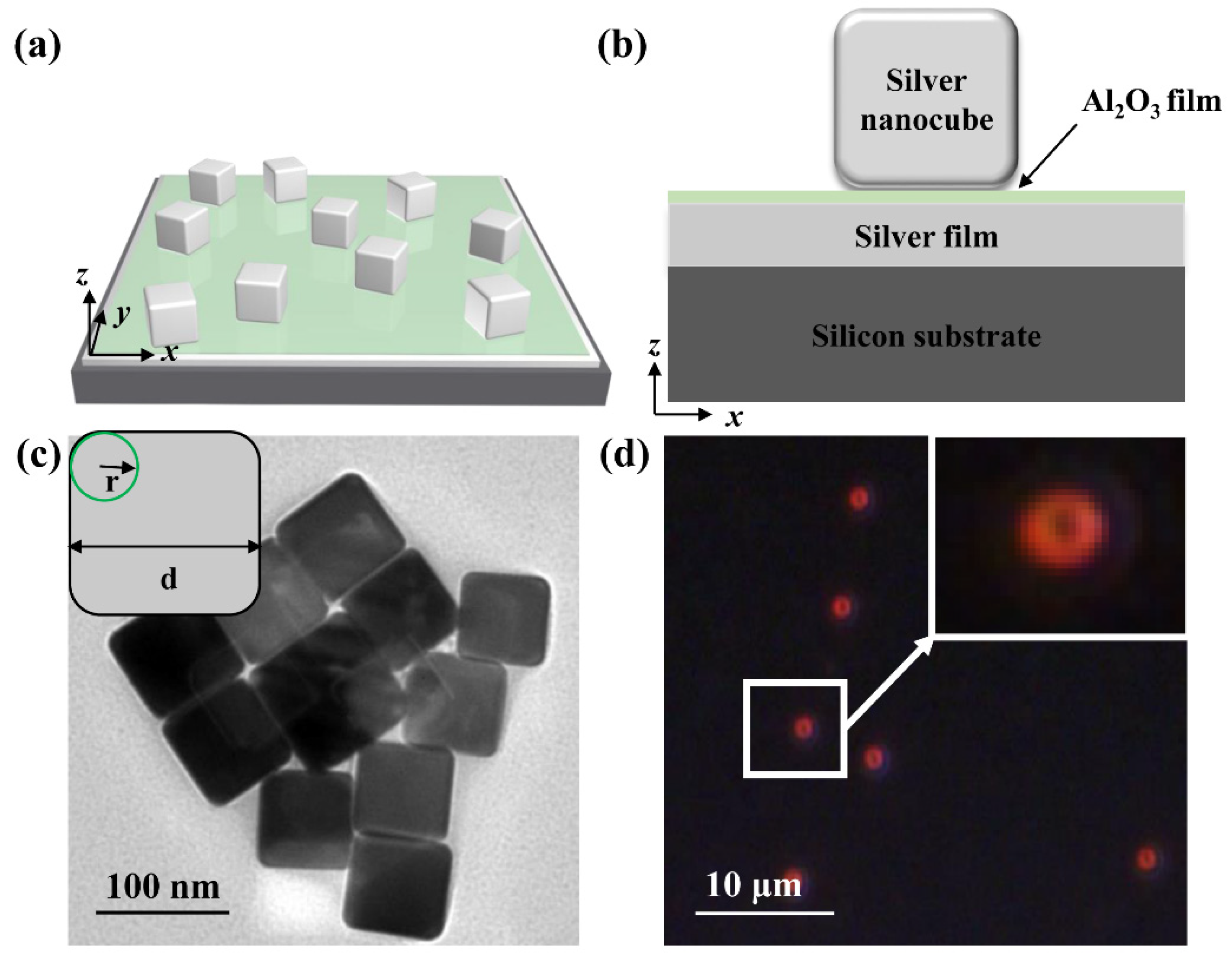
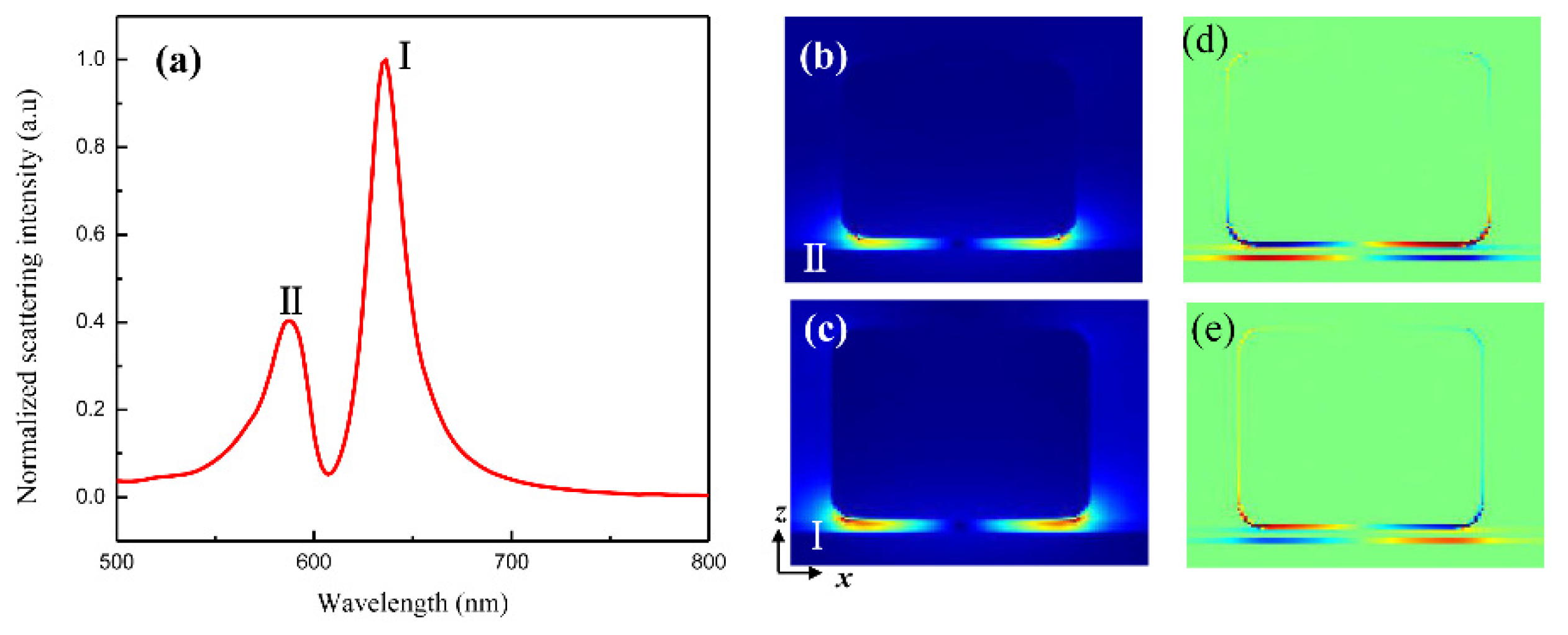
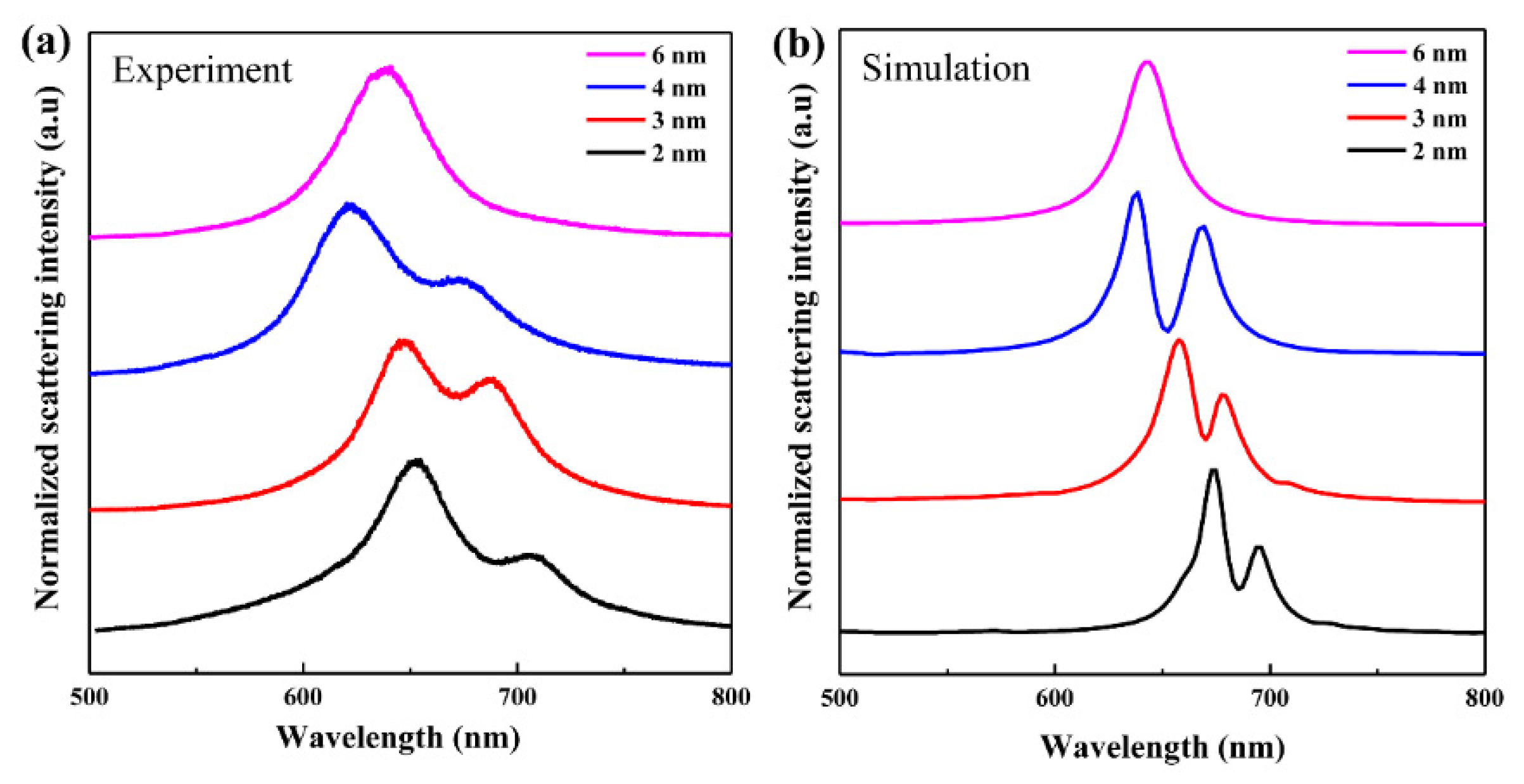
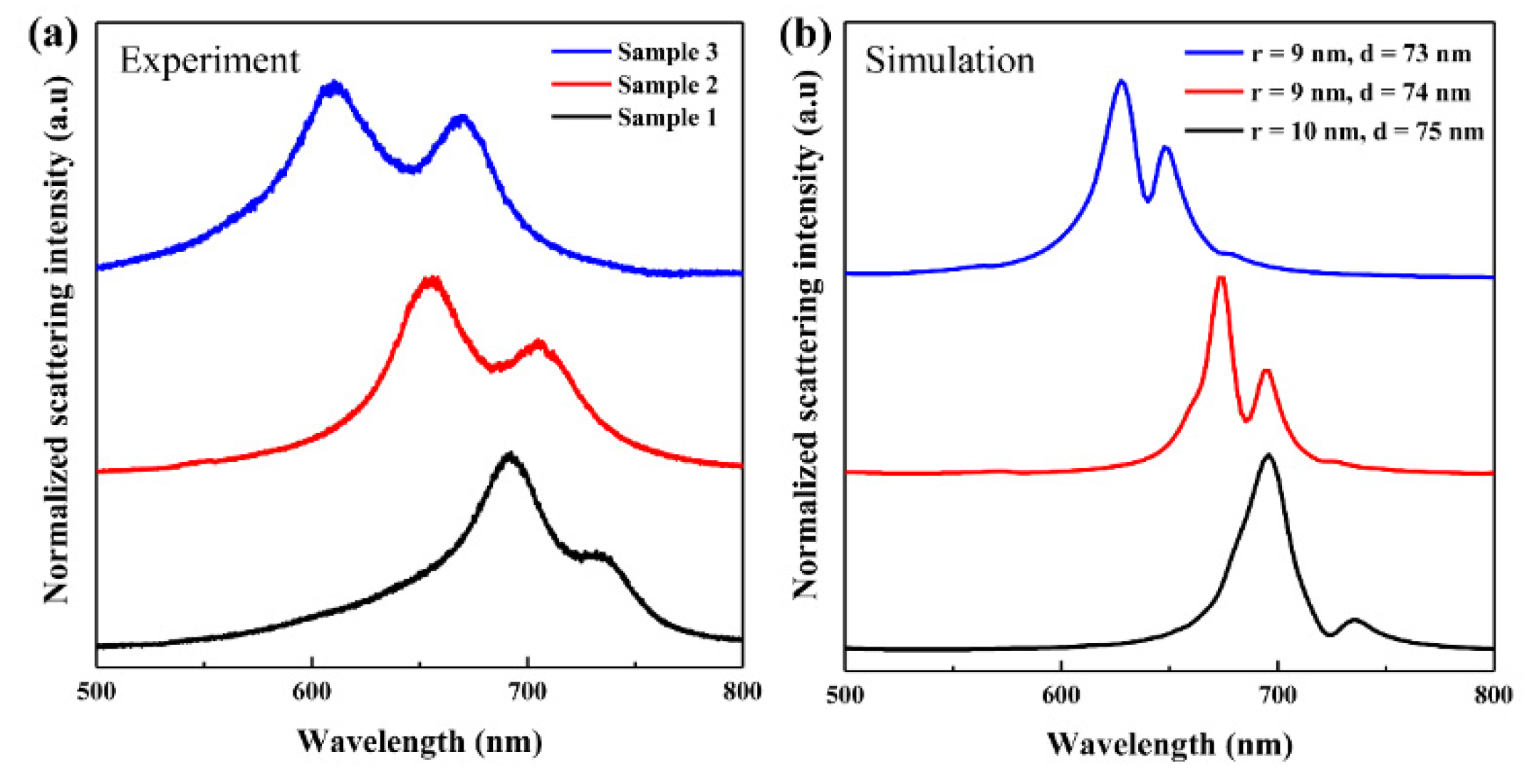
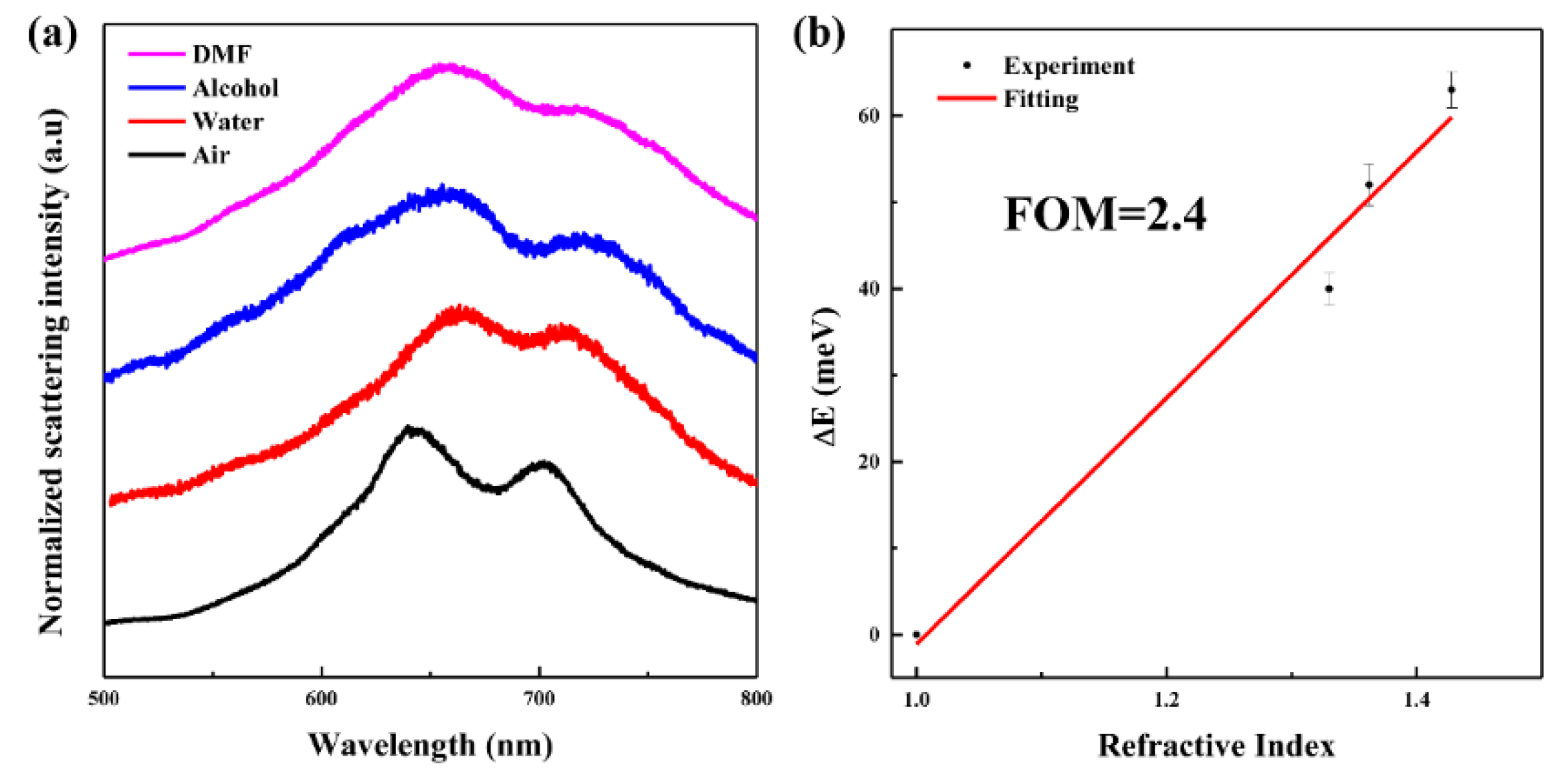
| Structure | Parameters |
|---|---|
| The face-to-face width of the cube (d) | 75 nm |
| The rounded corner size (r) | 10 nm |
| The thickness of the Al2O3 film | 2 nm |
| The thickness of the silver film | 80 nm |
© 2020 by the authors. Licensee MDPI, Basel, Switzerland. This article is an open access article distributed under the terms and conditions of the Creative Commons Attribution (CC BY) license (http://creativecommons.org/licenses/by/4.0/).
Share and Cite
Yao, F.; Li, F.; He, Z.; Liu, Y.; Xu, L.; Han, X. Tunable Fano Resonances in an Ultra-Small Gap. Appl. Sci. 2020, 10, 2603. https://doi.org/10.3390/app10072603
Yao F, Li F, He Z, Liu Y, Xu L, Han X. Tunable Fano Resonances in an Ultra-Small Gap. Applied Sciences. 2020; 10(7):2603. https://doi.org/10.3390/app10072603
Chicago/Turabian StyleYao, Fuqiang, Fang Li, Zhicong He, Yahui Liu, Litu Xu, and Xiaobo Han. 2020. "Tunable Fano Resonances in an Ultra-Small Gap" Applied Sciences 10, no. 7: 2603. https://doi.org/10.3390/app10072603
APA StyleYao, F., Li, F., He, Z., Liu, Y., Xu, L., & Han, X. (2020). Tunable Fano Resonances in an Ultra-Small Gap. Applied Sciences, 10(7), 2603. https://doi.org/10.3390/app10072603




